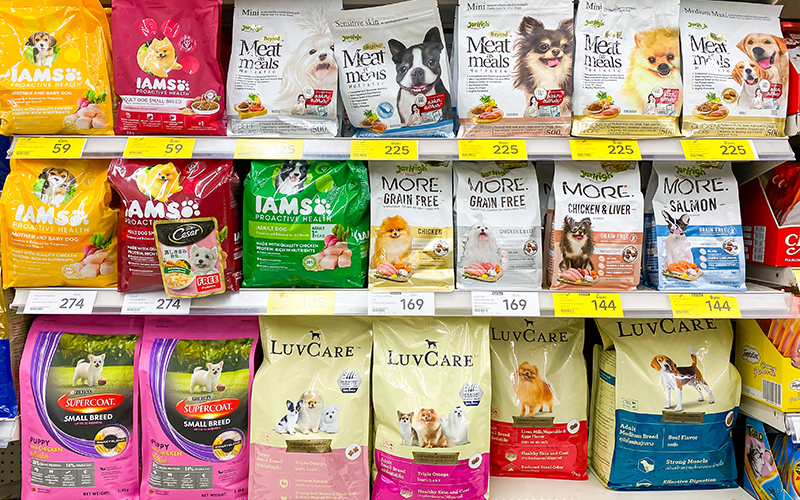Your Pet Food Label Explained

Many of the terms used to describe pet foods on labels and in advertising materials are not legally defined. a product described by the undefined terms is not held up to any standard higher than would be required for any other pet food on the market and should not be interpreted as meaning the product is necessarily of higher quality or greater nutritional value.
Here are some of the defined terms you see on your pet food label and how they relate to the nutritional value of the product.
What Does a 'Natural' Label Mean?
A “natural” ingredient must be derived from plant or animal materials, or mined out of the ground in final form (for example, salt or calcium carbonate). Those materials can be further ground or otherwise physically altered, dried, cooked, extracted, purified, fermented, or treated with enzymes and still be considered “natural.” However, if production of the ingredient requires any chemical changes, if any synthetic chemicals are added to that ingredient or to the product, or if the ingredient is treated with radiation, they no longer meet the AAFCO definition of natural.
For a finished pet food product to be “natural,” ALL ingredients must meet the AAFCO definition. The inclusion of an artificial preservative, color, or flavor, directly or by inclusion in another ingredient, would negate any use of the term. An exception is made to allow the use of chemically synthesized vitamins, minerals, or other trace nutrients (for example, taurine or amino acids) as may be needed to ensure the food to be nutritionally complete and balanced. In that case, however, a disclaimer must be made in association with the term “natural” to clarify that the product does contains small amounts of synthetic trace nutrients, for example, “natural with added vitamins and minerals” or “natural with added vitamins, minerals, and other trace nutrients.”
What Does a 'Human-Grade' Label Mean?
Briefly, companies must provide documentation that EACH AND EVERY ingredient is in fact fit for human consumption. Further, it must be proven that the pet product is produced in a facility permitted to manufacture human food in accordance with the US Food and Drug Administration’s Current Good Manufacturing Practices. So, claiming something like “made with human grade ingredients” may be false and misleading unless the product as a whole also complies with all human food production standards.
As the AAFCO “human grade” guideline is relatively new, only a handful of products have passed regulatory muster to date. This appears contrary to the wide array of “human grade” pet foods one may see in the marketplace today. Unfortunately, it is much more difficult for regulators to police web sites vs. product labels. Thus, any company that claims its products to be “human grade” on its website when such a claim does not appear on the label itself should be eyed withcaution . In general, raw pet foods can’t meet the AAFCO requirements for a “human grade” claim. The labels of raw meat and poultry sold for human consumption must bear cooking directions to mitigate the risk of harmful bacteria, whereas raw pet foods are expressly intended to be fed uncooked.
What Does an 'Organic' Label Mean?
“Organic” is very different from “natural.” Rather, it describes a method of production, where crops are grown without use of synthetic herbicides or fertilizers, and are not genetically engineered. Animals raised to provide organic meat, milk or eggs must be fed organically-grown feed, and cannot be treated with synthetic pesticides, antibiotics, or growth promotants. Companies that are accredited by the USDA (“certifying bodies”) inspect the facilities and records of the farmers and food companies to verify that they are following all the rules.
An “organic” food must contain at least 95% organic ingredients, while something “made with organic ___” must contain at least 70% organic ingredients. The remaining percentage must be comprised of ingredients expressly permitted by law. Any product containing less than 70% is not permitted to use the word “organic” on the label other than to describe the applicable ingredients in the ingredient list.
“Organic” product labels may bear a USDA Organic Seal. For either “organic” or “made with organic” products, the label MUST bear the name of the certifying body (for example, “Certified organic by ____”). If the label does not bear this information, it does not meet the “organic” standards, and any claims on the label suggesting otherwise must be eyed with due scrutiny.
Unlike foods for human consumption and feeds intended for food-producing animals, there are no specific regulations in place for “organic” pet foods at this time. Until such regulations are in place, those for human foods are being applied to pet foods. If a pet food company’s web site claims the product or ingredients to be “organic” in some fashion, but that information does not appear on the label itself, the product may not be in compliance with the regulations.
Check out these websites for more information on pet food nutritional labels:
FDA Center for Veterinary Medicine:
http://www.fda.gov/AnimalVeterinary/
FDA Recall List:
http://www.fda.gov/AnimalVeterinary/SafetyHealth/RecallsWithdrawals/default.htm
Pet Food Institute:
http://www.petfoodinstitute.org/
Pet Food Institute Consumer Information:
Articles by Specialty
- Cardiology (18)
- Large Animal Internal Medicine (23)
- Neurology (16)
- Oncology (20)
- Small Animal Internal Medicine (25)
Articles by Animal
- Cats (35)
- Dogs (47)
- Farm Animals (5)
- Horses (12)
